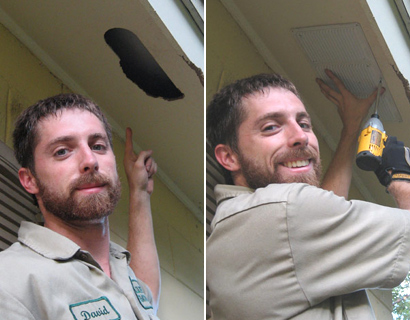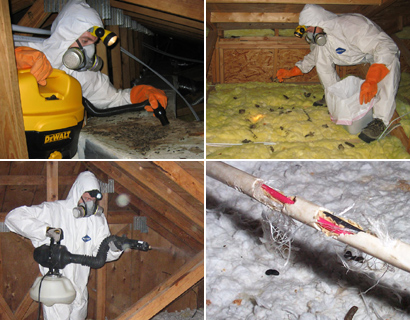- How We Solve Virginia Wildlife Problems
How We Solve Arlington & Alexandria Wildlife Problems
INSPECTION: Once on site, we will perform a full inspection of your home and property. This allows us to use the correct strategy and traps. If the animals are in an attic, a full building inspection is crucial, including the following:
- All ground-level areas, such as piper or A/C line entry & exit areas, A/C chase bottoms, ground-level vents, etc.
- All mid-level areas, such as dryer vents, siding gaps, first floor eaves or dormers, etc.
- We inspect the entire roof, including all plumbing stacks, ridge caps, vents, and other potential gaps or holes.
- We also inspect inside your attic, to identify animals and damage they have caused.
- If the animals are outside, we notice many subtle clues that will assist us in a successful strategy.
TRAPPING, EXCLUSION, REMOVAL: Once we understand what animal species we are dealing with, and the problem, we use the most effective means of removing the animals. We use dozens of different types of traps.
- Trapping - If trapping the animal(s) in live cage traps, trap type, set, and location are crucial to success.
- Exclusion - Oftentimes, we are able to simply set one-way doors or other exclusion devices that allow the animals inside a building to safely exit, but never get back inside.
- Removal By Hand - Sometimes we actually remove animals by hand, or with special tools like snare poles.
- The Law - In all cases, we obey state and local laws regarding wildlife, but aim to take the most humane approach.
ENTRY HOLE REPAIRS: Repairs are a crucial step in the wildlife removal process. In many cases, such as bat or rodent control, the job cannot be performed without detailed repairs, and in all cases, sealing the entry holes shut ensures that no future wildlife will ever enter your home.
- 100% of the entry holes must be found, and sealed shut, or the job is not complete.
- Our repairs are professional contractor grade, look good, and when applicable we use steel, which rodents such as rats or squirrels are unable to chew through.
- We give a written guarantee on our repairs against any future animal entry.
ATTIC DECONTAMINATION SERVICES: It may be desirable to clean your attic after we've removed the animals. They can leave behind large amounts of droppings, urine, hair, oils, food, nesting material, and so on. These remnants can attract insects like cockroaches, and the scent left behind can encourage new animals to chew their way into your house. You might experience odor problems from the waste. It's possible that mold will grow on waste areas.
- We remove or vacuum all droppings, or remove all the soiled insulation.
- We fog the attic with a special enzyme-based cleaner that destroys any organic matter and deodorizes the space.
- We repair damage, such as ductwork, electrical wires, pipes, insulation, and more.
Rodents are one of the best when it comes to finding ways into our homes. They can use their teeth and nails to make their way through the smallest cracks or gaps in your home. Once they are in, they can easily make their way into your walls to create nests and pathways to food sources in the walls of your home. Rodents can cause serious damage to not only your property, but your health as well. If you have any questions or if you have a wildlife problem in your property, feel free to give us a call. We answer our phones 24 hours a day 7 days a week to better service your wildlife removal needs. Our Team services the following cities: Old Town, Eisenhower Valley, Rosemont, The Berg, Parker-Gray, Del Ray, Arlandria, West End, North Ridge, Hollin Hills, Franconia, Groveton, Hybla Valley, Huntington, Belle Haven, Mount Vernon, Fort Hunt, Engleside, Burgundy Village, Waynewood, Wilton Woods, Rose Hill, Virginia Hills, Hayfield, Kingstowne, Fairfax, Vienna, Burke, and Reston. We also service the following counties: Arlington County, Prince George's County, Clarke County, Culpeper County, Rappahannock County, Spotsylvania County, and Stafford County.
Other Arlington & Alexandria animal pest control topics:
What do Rehabilitators do With Squirrels
What is the Best Material to Exclude Bats
Is it Legal to Trap a Skunk
What to do if a Opossum Enters Your Home
Are Opossums Dangerous to Cats, Dogs, or Other Pets?
What Areas can Pigeons Enter a House Through?
To learn more about our services, visit the Arlington & Alexandria wildlife control home page.
This month's wildlife how-to article: What are some ways to kill a skunk in the yard?
What are some ways to kill a skunk in the yard?
A skunk may find a way into your yard most especially when it finds food or shelter. Stray skunks may create temporary dens in the yards and may visit the dens from time to time. Skunks may store up food and materials used in the making of their dens, and they are smart enough to hide teir foods away from the privy eyes of humans and other animals. There are several ways to kill a skunk in the yard but the most human methods include:
- Bait trapping,
- Shooting, and
- The use of electric fencing
Other methods of killing skunks in the yard , including poisoning, are not humane , and such may force the skunk to die somewhere secluded – this situation may be hazardous to the environment.
Bait trapping is the most effective way to kill a skunk in the yard. This could be a one-door or two-door trap and all you have to do is to set the bait close to the trigger plate where the animal can be captured and the door automatically shuts. Skunks prefer the meaty or fishy foods, and if you want to use seeds or nuts, then make sure you wrap the bait with some pea butter because skunks are easily enticed with good smelling foods. To make bait trapping more effective, you should consider lining the outer side of the trap with some of the bait to ensure that the animal eats its way into the trap. Make sure the trap is perfectly covered to ensure that the animal doesn’t suspect.
A body snap trap can also be used to kill a skunk in the yard, in place of a bait trap. The body snap simply grabs the animal by the head or neck and it is set in such a way that the skunk cannot drag the trap away from its position. Once the animal enters into the trap, the snaps triggers and the animal is choked to death. Though the use of poisoned food can be effective in killing skunks in the yard, such killing can be inhumane and some other animals such as pet dogs and cats may accidentally eat the poisoned food and die. For this reason, it is better not to apply a poisoned food to kill a skunk in the yard.
The use of electrical fences creates electrical shock in the body of a skunk in the yard, and the animal may die if the electrical impulses are too high.





